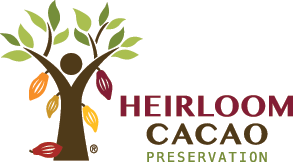/Chocolate Resources/Chocolate Blog/Hawaii: The North Pole of Cacaol

Hawaii: The North Pole of Cacaol

I know, it sounds crazy right? Hot days, warm tropical nights...how could Hawaii be the "North Pole" of anything? Well, those lovely cacao trees that give us chocolate are very particular about where they will grow and flourish. And it turns out that Hawaii is just on the cusp of where cacao can be grown in the world.
Cacao trees are grown with success only 20 degrees north or south of the equator (that invisible line that divides the earth into the northern and southern hemispheres), with the majority of the world's cacao grown in regions that are only 10 degrees north or south - the wetter and hotter climates.
The southern tip of the Hawaiian islands is just a little over 18 degrees north of the equator. By the time you travel just a little bit north on the Big Island of Hawaii (which is the southernmost island) to the Kona airport, you are pretty much exactly 20 degrees north of the equator. So any cacao grown any further north is technically outside of the 20 degrees north "belt". But amazingly, cacao is currently being grown on all of the Hawaiian islands! This makes Hawaii the only place in North America where cacao can be farmed.
The islands have many different micro-climates - on the Big Island you can even ski at the top of Mauna Kea and go to the beach in the same day! But it doesn't have to be that extreme - if you drive 30 minutes away from one location you could have an environment that is drier or wetter, or with a different type of soil. So the decision to grow cacao at any location on the Islands has to be chosen carefully. In addition, the constant presence of the tradewinds create a stressor on the trees, particularly the strong winter winds in February and March. These winds can tear leaves from the cacao trees, leaving the trees vulnerable to infection, and zapping energy needed to grow mature fruit.

The climate can have an impact on the fat (cocoa butter) content and flavor of the beans from year to year, such as the amount of rainfall. This also means that trees with the same genetic lineage grown on different islands, or even different farms on the same island can produce beans that have very different flavor profiles based on differences in soil composition and climate.
The majority of cacao trees grown in Hawaii were planted from seeds (as opposed to grafting, which is often done in other growing regions). As a result, there is a lot of diversity in terms of the types of cacao trees that are growing in Hawaii and the genetic composition of individual plants. Why the diversity? The cacao bean is a "child" of the mother tree but will probably have another parent adding to the genetic mix of the bean itself - as tiny midge flies are responsible for pollinating the cacao blossoms and they can fly from tree to tree indiscriminately.
Growing cacao in Hawaii - Advantages & Challenges
How is growing cacao in Hawaii different from other places in the world? The cacao farming industry in Hawaii is quite young - efforts to grow cacao on the islands didn't start in a major way until the 1990's. There are both advantages and challenges to growing cacao on the Hawaiian Islands compared to other cacao growing regions.
ADVANTAGE - the lack of most pests and cacao diseases that are a constant threat, or at worst, have crippled the population of cacao trees in other parts of the world. For example, witch's broom a disease caused by fungus that wiped out about 70% of Brazil's cacao crop in the late 1980's & early 1990's. Few pests and diseases is key to a thriving crop.
CHALLENGE - there is constant concern about protecting the Hawaiian ecosystem by not accidentally introducing foreign pests or disease and farmers have to be very careful about the types of crops they attempt to grow.

CHALLENGE - In many other parts of the world, cacao has been grown for generations. All of the knowledge about how to grow, tend, harvest, dry and ferment cacao has been passed down among families. Cacao hasn't been growing long enough in Hawaii for this depth and breadth of knowledge to be shared in this way.
ADVANTAGE - BUT, Hawaii has another kind of knowledge - agricultural research expertise. The universities have agricultural departments with extensive knowledge about growing crops in Hawaii and cacao has been the subject of study and research resources, especially by CTAHR.
CHALLENGE - The actual costs of growing cacao in Hawaii are often higher as well. Given that the Hawaiian islands are isolated, power and water are more expensive in Hawaii than in other cacao growing regions. The cost of land and labor is very high compared to other cacao growing regions. Also any materials that need to be shipped from the mainland are going to be costly. For example, one threat to young cacao trees are rose beetles - they are voracious! As a result, young cacao trees are often grown in cages for the first year, which adds to the costs of planting a crop - both in terms of labor, and the costs of the cages themselves.

Young cacao trees in mesh cages
How is chocolate made from Hawaiian cacao different?
The short answer is that it isn't different - the cacao trees grown on the Islands started from root stock brought over from other countries over many, many years. So it's up to the cacao growers to pick the best flavor genetics and hone their post harvest processes to make sure that the chocolate produced from Hawaii grown cocoa beans is the best it can be.

Cacao pods harvested from the trees
Bean to bar chocolate in Hawaii
As with many parts of the U.S., Hawaii has seen growth in the bean to bar chocolate industry in the last 10 years. There is not enough Hawaiian cacao to support full production for all of these chocolate makers yet, but many of them do make at least one bar from Hawaiian-grown cocoa beans. As more chocolate makers use Hawaiian grown cocoa beans to make fabulous fine chocolate, there are more opportunities for Hawaiian chocolate to become recognized on the world stage. Recently cacao grown in Hawaii was designated as heirloom by the Heirloom Cacao Preservation Fund (HCP) for it's exceptional flavor! Here are some of the chocolate makers in Hawaii that make bean to bar chocolate from Hawaiian grown cocoa beans:
- Lonohana Estate Chocolate
- Madre Chocolate
- Manoa Chocolate
- Original Hawaiian Chocolate Factory
- Lydgate Farms
- Waialua Estate Chocolate
The future of cacao in Hawaii - the "Napa Valley" of chocolate?
There is a fantastic opportunity to create an ecotourism market around cacao and chocolate in Hawaii, similar to what Napa Valley has done for the wine industry in California. In many other places in the world, cacao is grown off the beaten path in places where tourists don't normally go. Hawaii is fortunate to already have a bustling tourism industry. Again, the cacao industry on the islands is still very young - there are farms ranging in size from 1/4 acre to 30 or 40 acres. There is maybe 100 acres of cacao growing in Hawaii across the state. Imagine if one day there were hundreds of fine flavor, healthy cacao trees and Hawaii became known as a cacao and chocolate tourism destination!

A pod that has been cracked open - look at those beautiful beans!
Experience cacao farming in Hawaii
Ecole Chocolat is offering a program that will allow you to experience cacao farming first hand! The Cacao Experience in Hawaii is an opportunity to join Daniel O'Doherty and Dylan Butterbaugh for an intense but fun hands-on learning experience at the Maui Ku‘ia Estate cacao farm. You will gain a deeper understanding of modern best practices in cacao cultivation and post-harvest processing, and how this impacts bean flavor and quality. Be ready to dive headfirst into cacao planting, protecting, harvesting, fermenting and drying over four days of immersion in the processes.
Hawaii Chocolate and Cacao Association
If you're interested in learning more about growing cacao in Hawaii, visit the Hawaii Chocolate and Cacao Association website
Want to learn more about making delicious chocolates and confections? Check out our Professional Chocolatier Program!
Get reminders about upcoming classes! To receive program updates and news, click the link below.
Photography by Jessica Washburn, Bliss Chocolatier and Ecole Chocolat





